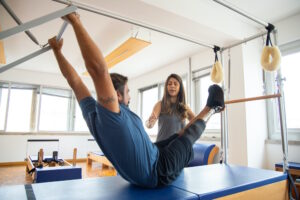
Pilates equipment plays a crucial role in the practice of Pilates, providing resistance, support, and assistance to enhance the effectiveness of the exercises. Springs, straps, and other components are integral parts of Pilates equipment, and understanding their anatomy is essential for a comprehensive understanding of Pilates practice. In this article, we will explore the meaning and significance of springs in Pilates, discuss the various equipment used in Pilates, highlight the piece of equipment primarily used by Joseph Pilates and his apprentices in his original New York City studio, and delve into the benefits of Pilates springs.
What do the springs mean in Pilates?
In Pilates, the springs are an essential component of the equipment and play a crucial role in providing resistance, assistance, and control during exercises. The springs offer variable resistance that challenges the muscles throughout the range of motion, allowing for both concentric and eccentric muscle contractions. The resistance provided by the springs helps engage and strengthen the muscles while maintaining control and stability. The springs also offer assistance, supporting the body during certain exercises, helping with alignment, and allowing individuals to perform movements they may find challenging without the added support.
What is the equipment used in Pilates?
Pilates utilizes a range of equipment to facilitate and enhance the exercises. Common pieces of equipment include the reformer, Cadillac (also known as the trapeze table), Wunda Chair, Ladder Barrel, and various props such as the Pilates ring, resistance bands, and foam rollers. Each piece of equipment offers unique features and benefits, providing different levels of challenge, support, and versatility. The equipment is designed to target specific muscle groups, improve core strength and stability, enhance flexibility, and promote overall body conditioning.
Which piece of equipment consisting of pulleys and springs was primarily used by Pilates and his apprentices in his original New York City studio?
The piece of equipment primarily used by Joseph Pilates and his apprentices in his original New York City studio is the reformer. The reformer consists of a carriage that moves back and forth along a frame and is attached to springs of varying resistance. The springs provide resistance as the carriage is pushed or pulled, challenging the muscles and requiring control and stability. The reformer also incorporates other components such as footbars, straps, and pulleys, which add versatility and enable a wide range of exercises targeting different muscle groups.
What are the benefits of Pilates springs?
Pilates springs offer several benefits that contribute to the effectiveness of Pilates workouts. Firstly, the adjustable resistance provided by the springs allows individuals of varying fitness levels to tailor their workout to their specific needs and goals. The resistance can be increased or decreased by adjusting the springs’ tension, making it suitable for beginners as well as advanced practitioners. Additionally, the resistance provided by the springs challenges the muscles throughout the entire range of motion, leading to improved strength, flexibility, and control. The springs also offer support and assistance, making certain exercises more accessible and promoting proper alignment and technique. Overall, the springs in Pilates equipment enhance the effectiveness of the exercises and contribute to the development of strength, stability, and body awareness.
In summary, understanding the anatomy of Pilates equipment, including the springs, straps, and other components, is crucial for a comprehensive understanding of Pilates practice. The springs in Pilates provide resistance, assistance, and control during exercises, challenging the muscles and enhancing the effectiveness of the workouts. In addition to the springs, Pilates equipment encompasses a range of pieces, each offering unique benefits and targeting specific muscle groups. The reformer, primarily used by Joseph Pilates and his apprentices, utilizes pulleys and springs to provide resistance and support for a wide variety of exercises. The springs in Pilates equipment offer adjustable resistance, facilitate controlled movements, and contribute to the development of strength, stability, and body awareness. By utilizing the springs and other equipment in Pilates practice, individuals can enhance their workouts and experience the numerous benefits of this popular exercise method.